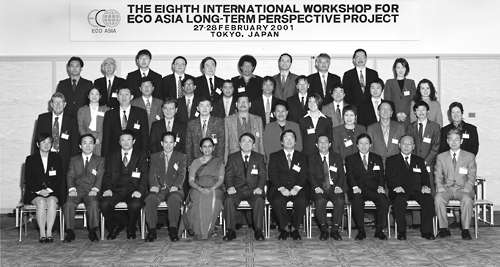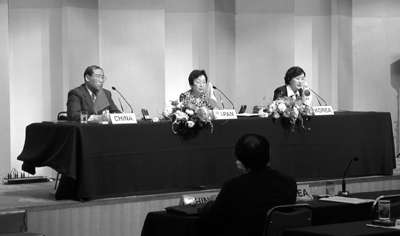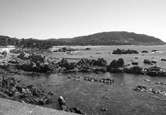Japan Environment Quarterly -Vol.6 No.2 June 2001-
 The
Japanese Cabinet recently approved the 2001 edition of the annual White
Paper on the Environment. The main theme of the white paper this year
is "Wa no Kuni," making double-use of the character for "wa," which means
both "the environment" and "circulation," to describe "kuni," which means
country. The paper states that Japan's role is to become a country where
society has environmentally-sound material cycles that emphasize simplicity
and quality, and to contribute to the international community based on
the country's past experience.
The
Japanese Cabinet recently approved the 2001 edition of the annual White
Paper on the Environment. The main theme of the white paper this year
is "Wa no Kuni," making double-use of the character for "wa," which means
both "the environment" and "circulation," to describe "kuni," which means
country. The paper states that Japan's role is to become a country where
society has environmentally-sound material cycles that emphasize simplicity
and quality, and to contribute to the international community based on
the country's past experience.
To achieve this role, Japan needs to keep the activities
of society and the economy within the finite limits of the earth and encourage
all players in society to engage in dialogue to this end. The main components
of the paper are described below.
Section 1: Tasks for 21st century environmental policies and the basic countermeasures for environmental problems
Chapter 1: Changes and trends in environmental problems
This chapter goes into the character of the environmental problems
and the complex structure of their causes, after considering the
effects of various changes in socio-economic structures. It indicates
the direction society should be heading.
Chapter 2: Contribution to the international community based
on past results in environmental conservation
Production control procedures and eco-efficiency in Japan are at
a high level. The current surge in corporate environmental awareness
is expected to result in greater environmental conservation. Japan
should provide positive examples of changes in society in order
to contribute to sustainable development in the international community.
Chapter 3: Basic strategies for establishing "Wa no Kuni" (harmonious
and sustainable society)
Japan's new Environment Basic Plan is the compass for the country's
environmental policies in the twenty-first century, and provides
the basic strategies for a clean environment and sound material
cycles. This chapter describes the basic direction of environmental
policies and eleven strategic programs for the years to come. It
also describes in detail how Japan's prefectures and government
ministries are addressing environmental problems.
Section 2: Pursuing societal and economic activities symbiotic with the earth
Chapter 1: Environmental problems require human society to change
direction
This chapter presents the view that threats to human survival are
approaching, as evidenced by the worsening impacts of global warming,
inefficient resource use and the accumulation of harmful chemicals
in the environment. It asserts that environmental problems caused
by human activity will become a key issue of environmental politics
in future.
Chapter 2: How to promote efforts to prevent global warming
This chapter describes the process of the formation of international
frameworks, targets and rules relating to global warming.
Chapter 3: How to promote activities to create a society with
environmentally-sound material cycles
After describing the present situation, this chapter points the
direction for measures to deal with waste disposal and recycling.
It also shows the way for the formation of a society with environmentally-sound
material cycles, and the significance of related laws.
Chapter 4: How to cope with problems caused by chemical substances
This chapter delves into the subject of chemical substances
and describes current trends. The production, use and emission of
chemical substances are regulated, however the stock of knowledge
and information about them is not adequate. Greater efforts are
needed for information collection and disclosure.
Chapter 5: How to accelerate overall activities for environmental
conservation
This chapter describes examples of activities being promoted
in various parts of Japan and their significance. It addresses the
need to use economic measures and an effective policy mix.
Section 3: Sustainable society created by environmental communication
Chapter 1: The role and potential of environmental communication
This chapter goes into the impacts, the current situation and the
potential of "environmental communication," one of the most important
measures for establishing partnerships--among individuals, industry,
and governments--in order to create a sustainable society.
Chapter 2: Encouraging the participation and collaboration of
each sector
This chapter describes how sectors of society communicate with
each other.
Chapter 3: Building various partnerships for environmental conservation
This chapter explains the role of governments in building the
foundations to activate environmental communication needed for the
establishment of sustainable society.
8th International Workshop on the ECO ASIA Long-term Perspective Project
On 27 and 28 February the Ministry of the Environment organized the 8th International Workshop on the ECO ASIA Long-term Perspective Project in Tokyo. A major objective of the workshop was to gather input regarding the draft report from the second phase of the Long-term Perspective Project to the World Summit on Sustainable Development to be held in 2002. Another objective was to confirm the common understanding of participants that the provision of scientific information and strategic environmental policy options is essential to solve environmental problems in this region, and to discuss future directions. Some of the main discussions are outlined below.
1. Status of LTPP progress:
Draft reports were presented regarding research on climate change, urban
environments and other fields, research on environmental awareness in
the Asia-Pacific region, and the state and prospects of regional cooperation.
2. Results of Phase 2 of the LTPP:
A discussion was held about reporting of the final results, and providing
input to the Summit in 2002.
3. Directions after Phase 2:
A discussion was held about the follow-up to this phase. Participants
re-confirmed the importance of providing a scientific basis to policy-makers
for policy-formulation in order to achieve sustainable development, and
confirmed the importance of a new project after Phase 2. The participants
also supported the idea of transformation of this workshop into a panel
with mandate in particular: i) providing policy option proposal for ECO
ASIA Ministerial discussions, ii) guidance to a new project 'Asia Pacific
Environmental Innovation Strategy', and iii) providing possible input
to the Eminent Persons Forum
4. Eminent Persons Forum:
Views were shared about the topics for the "Eminent Persons Forum on Environment
and Development in the Asia-Pacific" (tentative name), which was proposed
by Environment Minister Yoriko Kawaguchi in September last year at ECO
ASIA 2000 in Kitakyushu. Ministers present at that congress supported
the proposal, and preparations are now under way.
As a background note, Phase 1 of the ECO ASIA LTPP (1993-1997) made predictions
of the regional environment in the year 2025 and proposed concepts for
sustainable development in the region (eco-consciousness, eco-partnerships,
eco-technology/eco-investment, and eco-policy linkages). Objectives of
Phase 2 (1998-2001) include clarifying environmental problems that could
arise from various development scenarios in the region, providing input
to ECO ASIA Congresses so that they can contribute to the Summit in 2002,
and building capacity of individuals and organizations through participation
in the project.
Participants in this workshop included a total of thirty-four representatives
from Japan and twelve other Asia-Pacific countries (Bangladesh, Cambodia,
China, Fiji, Indonesia, Kazakhstan, Malaysia, Mongolia, Philippines, Singapore,
Sri Lanka and Thailand) as well as from related international organizations.

Group photo from 8th International Workshop
on the ECO ASIA Long-term Perspective Project (February 27 - 28, 2001)
The Third Tripartite Environment Ministers Meeting of Korea, China and Japan
The Environment Ministers of Korea, China and Japan met in Tokyo on
7 and 8 April for the annual Tripartite Environment Ministers Meeting
(TEMM). This meeting completed the first cycle, after Korea and China
hosted in the two previous years. This year, Ms. Kawaguchi Yoriko, Environment
Minister of Japan, welcomed Ms. Kim Myung Ja of the Ministry of Environment
of the Republic of Korea and Mr. Xie Zhenhua of the State Environmental
Protection Administration of the People's Republic of China.
Five priority project areas determined at the previous
TEMM meeting were (1) raising consciousness of environmental community,
(2) fresh water (lake) pollution prevention, (3) land-based marine pollution
prevention, (4) cooperation in the field of environmental industry, and
(5) ecological conservation in Northwest China. This year, reports were
presented on these project areas, with notable progress including a workshop
on an environmental education network, creation of the TEMM web site and
a technical workshop on ecological conservation in Northwest China. Progress
has also been made in the planning of other work in each prioritized area
The Ministers also discussed the issues of climate change
and shared the common recognition that a successful outcome of the resumed
COP6 is vital for bringing the Kyoto Protocol into force as early as possible.
The Ministers expressed their hope that the US government will actively
work with all the Parties to attain such a successful outcome.
The Ministers expressed a great concern about the degradation of natural
conditions in Northwest China and affirmed their recognition to formulate
and implement TEMM projects in this area and in all Asian region to address
this concern. These projects are expected to contribute to ecological
conservation following a step-by-step approach. The Ministers also shared
the recognition that the three countries should promote cooperation for
systematic studies on sand dust (yellow sand or kosa), which is exacerbated
by soil degradation in order to find out better ways to solve this problem.
In addition to these topics, the Ministers heard reports
on a wide range of ongoing bilateral and multilateral environmental projects
involving the three countries, and encouraged further efforts.
The next Tripartite Meeting will be held in Korea. The
Tripartite Environment Ministers Meeting Official Page can be found on
the Internet at http://www.temm.org/.

Three Ministers at the joint press conference (from left
to right, Mr. Xie, Ms. Kawaguchi, Ms. Kim)
Breeding Success of Crested Ibis in Japan
 The Sado
Japanese Crested Ibis Conservation Center has had a successful breeding
season. Kin was the only crested ibis (Nipponia nippon) of Japanese birth
when China presented You-You (male) and Yang-Yang (female) to Japan in
1998. This pair produced chicks, named Yu-Yu, Shin-Shin and Ai-Ai. China
presented Mei-Mei for Yu-Yu in 2000. During the 2001 breeding season,
You-You and Yang-Yang produced seven chicks (one died), and Yu-Yu and
Mei-Mei had six chicks (one died), bringing the total number of chicks
to thirteen.
The Sado
Japanese Crested Ibis Conservation Center has had a successful breeding
season. Kin was the only crested ibis (Nipponia nippon) of Japanese birth
when China presented You-You (male) and Yang-Yang (female) to Japan in
1998. This pair produced chicks, named Yu-Yu, Shin-Shin and Ai-Ai. China
presented Mei-Mei for Yu-Yu in 2000. During the 2001 breeding season,
You-You and Yang-Yang produced seven chicks (one died), and Yu-Yu and
Mei-Mei had six chicks (one died), bringing the total number of chicks
to thirteen.
These are encouraging results compared with only two
chicks born last year. Of particular note is the higher rate of egg fertilization
(88%, compared to 29% last year), thought to be due to the birds' becoming
more accustomed to their surroundings of Japan.
Eighteen crested ibises are now kept in the Center, including the eleven
surviving chicks born this season. Because Japan and China have agreed
that offspring born of Yu-Yu and Mei-Mei are to be shared between the
two countries, three chicks will be sent to China. Details of transport
are now being discussed.
Starting with only one crested ibis in Japan at the
end of 1998, this breeding project has succeeded in increasing the number
of this endangered bird to eighteen in three years. With continued success
at this rate, the number of crested ibises in Japan could reach one thousand
in 2008. Handlers are now concerned about the possible negative effects
of inbreeding and the lack of the cages for the birds. One solution for
inbreeding is the exchange of crested ibises between Japan and China.
A new problem may arise when the number of the artificially
bred crested ibises increases significantly--will they be capable of nesting
and raising chicks? However, in May 2001, a pair of artificially bred
crested ibises reportedly succeeded in hatching and raising chicks, an
important precedent for releasing the crested ibis to the wild. It is
hoped the crested ibises bred in Japan can be re-established in nature
in the future.

Upper stand, Mei-Mei's chicks, Lower stand, Yang-Yang's
chicks (May 2, 2001)
'Japan's 88 Best Bathing Areas' Clean and Safe Water to Swim and Play
The Ministry of the Environment recently selected 88 of Japan's bathing
areas for national recognition. This system for recognizing good bathing
sites was introduced by the MOE in 1998, when 55 sites were selected for
the first time. In 2001, the winning sites were selected based on the
following revised criteria:
(i) water quality, natural environment such as scenic surroundings
(ii) environmental consideration and activities
(iii) safety
(iv) accessibility and amenities
Forty prefectures recommended 146 sites, from which the Committee For
Comfortable Bathing Sites selected the winning bathing areas for presentation
of award certificates. The next selection will be in three years.
 |
 |
 |
| Neshiko Beach (Nagasaki pref.) | Okazaki Beach (Hyogo pref.) | Issiki Beach (Kanagawa pref.) |
Results of Soil Pollution Survey
In April the Ministry of the Environment released the results of a survey on the state of soil pollution and related countermeasures (excluding measures dealing with agricultural soil and dioxins). The survey studied the situation at the end of March 2000, and targeted all urban and rural prefectures in Japan as well as cities designated under the Water Pollution Control Law. Based on the information ascertained by the prefectures, 117 events exceeded Environmental Quality Standards for soil pollution, a high level similar to the previous year.
Of the cases exceeding the standards, 44 related only to heavy metals, 63 to volatile organic compounds, and 10 to a combination of the two. Many of the other cases, in order of occurrence, related to trichloroethylene, tetrachloroethylene, cis-1,2-dichloroethylene, lead and arsenic.
Eleven local public bodies reported new ordinances, guidelines, and administrative guidance, bringing the total to 169 such bodies as of 1 July 2000.
Based on this survey, the Ministry of the Environment plans to continue committee discussions about the system of soil pollution countermeasures for the protection of the soil environment.
Town Meetings with Environment Minister
The Ministry of the Environment has been holding " Town Meetings", dialogue
between citizens and the Minister--at the instance of the Minister, Ms.
Yoriko Kawaguchi--to build better partnerships with the people of Japan.
During the meetings, held in five cities (Tokyo, Sendai, Osaka, Kanazawa
and Fukuoka), the Minister gave presentations about the government's environmental
policies and exchanged views with the participants. In conjunction with
the town meetings, roundtable conferences were also held, with the participation
of the Minister and officials of the Ministry, local business leaders
and representatives of local non-governmental organizations. Below are
excerpts of dialogue in the town meetings.
Participant 1: I would like the government will support local
activities more proactively.
Minister: We hope to support the expansion of good activities to
other local areas and can provide financial assistance and suggest useful
ideas to local people.
Participant 2: I think it is important to provide environmental
education to children, but more important is environmental education for
adults.
Minister: It is important that persons involved in environmental
policies have their views on the protection of the environment.
Participant 3: I would like to have information on the condition
of the environment and pollution in real time.
Minister: Information disclosure is very important. We have a regional
observation system for the atmospheric environment called "Soramamekun."
It provides brief reports about air pollutants in the Kanto area.
Participant 4: We need to raise the awareness of people who have
no interest in the environment.
Minister: I have some doubts about obligating people to have environmental
education, but it is important to promote interest in the environment
and to set up information desks to support concerned people.
Participant 5: I suggest that the Ministry of the Environment assess
environmental cooperation and local government projects?
Minister: The role of the government is not in assessing but in showing
criteria.
Opinion Survey on PRTR and Chemical Substances
Based on 'Law Concerning Reporting, etc. of Releases to the Environment
of Specific Chemical Substances and Promoting Improvements in Their Management',
Japan launched its Pollutant Release and Transfer Register (PRTR) system
this April. Leading up to the start of this system, the Ministry of the
Environment conducted an opinion survey of persons registered as environmental
monitors and released the results in April.
One major finding of the study is that more than 70
percent of respondents are concerned about chemical substances. Regarding
the PRTR system, more than 80 percent wanted it to indicate the extent
of negative impacts on humans and the ecosystem from chemical substances
emitted into the environment.
Asked what is the greatest source of concern about chemical
substances around them, the largest number of respondents (83.1 percent)
indicated emissions from factories, waste incineration facilities, etc.,
followed by vehicle exhaust (77.5 percent), agricultural chemicals (77.0
percent), and household items (75.4 percent). Only 0.9 percent responded
that they have no concern. Asked from what facilities they require emissions
data, the largest number of respondents (33.4 percent) stated they want
data from facilities in the cities or towns where they live.
More than 99 percent of respondents stated that *risk
communications are necessary or would become necessary in the future.
In most cases (about 80 percent) they expect that the local government
should play a key role in that area.
The survey targeted 1500 persons nationwide and had
a response rate of 84 percent.
* The term "risk communications" refers to sharing information
and promoting better understanding among governments, businesses, citizens
and NGOs, etc., in order to develop a common understanding about "environmental
risk" (threats of harmful impacts via the environment on the human body
and living environment).
Eco Town Plan in Yamaguchi
In May, the Ministry of the Environment and Ministry of Economy, Trade and Industry jointly recognized Yamaguchi Prefecture for its "Eco Town Plan."
As reported in the March issue, the Eco Town Plan program was launched in 1997 based on the "zero emissions" concept of urban and industrial planning. Yamaguchi Prefecture is the fourteenth area to be recognized. In Japan's Chugoku region, Hiroshima Prefecture has also gained this status.
Yamaguchi aims to establish "zero emissions society" by promoting efforts such as recycling, with the main projects including (1) making material for cement from incinerated waste, (2) making material for the chemical industry from waste plastic, (3) making material for cement from plastic waste, and (4) recovering raw materials from polyester products such as plastic bottles.
The national government provides grants for such recycling projects. In the case of Yamaguchi Prefecture, the Ministry of the Environment will provide grants to build recycling facilities and purchase equipment to make material for cement from incinerated waste, and the Ministry of Economy, Trade and Industry will provide grants for the maintenance of cement raw material facilities.
The Impacts of Global Warming on Japan 2001--Report Released
Office of Research and Information, Global Environment Bureau, Ministry of the Environment
In parallel with the preparation of the Third Assessment Report of the Intergovernmental Panel on Climate Change (IPCC) released in April this year, Japan's Ministry of the Environment launched the Working Group on the Impacts of Global Warming (chaired by Shuzo Nishioka, Director of the National Institute for Environmental Studies) under the Ministry's Commission on Global Warming (chaired by Yasushi Kitano, Professor Emeritus of Nagoya University) in fiscal year 1999. In just over one year the Working Group compiled a report on the impacts of global warming on Japan, with the participation of a total of 66 authors.
The resulting report is titled "The Impact of Global Warming on Japan--2001."
The report deals with past and predicted changes in Japan's climate; impact assessments of global warming on terrestrial ecosystems, agriculture, forestry and fisheries, hydrology and water resources, marine environments, social infrastructure and health; economic assessments of impacts; detection and monitoring of impacts; and adaptation and vulnerability assessments. It also compiles the scientific knowledge accumulated until now regarding questions about the changes predicted in the Japanese archipelago and ways that lifestyles will change, as well as what responses are needed to the changing climate that accompanies global warming caused by the increase of greenhouse gases from human activities.
This is the third report about the impacts of global warming on Japan. During the five years since the previous report, progress has been made in research on global and regional climate scenarios as well as impact assessment methodologies. In addition, the body of research regarding impacts on Japan has expanded. Furthermore, since the global warming trend has been confirmed and the importance of adaptation measures has grown, this report also covers adaptation measures in each field.
This report will be utilized to provide information to not only specialists but also to the general public, and it is hoped that its outcomes will also be used in the preparation of the IPCC's Fourth Assessment Report.
EVENTS
| 2001 | |||
| August | |||
| The 11th Asia-Pacific Seminar on Climate Change (Kitakyushu, Japan) | September | ||
| 24-29 | Intergovernmental Panel on Climate Change 18th general meeting (London, UK) | ||
| October | |||
| 13-14 | Environment Congress for Asia and the Pacific 2001 (Tokyo, Japan) | ||
| 15-19 | 6th International Conference on Mercury as a Global Pollutant (Minamata, Japan) | 29-3 Nov. | 31st International Tropical Timber Organization (Yokohama, Japan) | 29-9 Nov. | COP7, UNFCC (SABSTA15, SBI15) (Marrakesh, Morocco) |
Ministry of the Environment Government of Japan
moe@env.go.jp